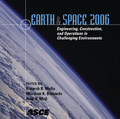Cratering by a Subsonic Jet Impinging on a Bed of Loose Particles
Publication: Earth & Space 2006: Engineering, Construction, and Operations in Challenging Environment
Abstract
We report on new experiments undertaken in a study of cratering caused by a turbulent jet associated with, for example, rotorcraft and rocket-propelled vehicles during landing and take-off operations. The experiments were performed using a subsonic air jet exiting a nozzle vertically and impinging upon a horizontal bed of loose particles. To study the high velocity jets associated with rotorcraft and rockets we observed cratering caused by flows about four times stronger than previously studied jet flows. Three bed materials were used: spherical glass beads (80-μm mean diameter, 2.44 g cm–3), sand (130 μm mean diameter, 2.65 g cm–3) and crushed polypropylene particles (6 mm mean diameter, 0.9 g cm–3). These last two materials, sand and polypropylene, were angular, non-spherical particles and are thus geometrically representative of natural soils. This study is distinguished from earlier efforts by our focus on, among other things, high-velocity jets. Our experiments reveal two end-member geometries of craters associated with an impinging jet that can be described as either relatively "weak" or "strong". Under a weak jet a single crater is formed in which sidewall slopes are at or below the angle of repose of the material. The shape of the crater persists after the jet is shut off. Under a strong flow, however, a temporary crater-within-a-crater forms. The inner crater has sidewalls that are steeper than the material angle of repose; in contrast, the shape of the outer crater is conical with sidewall slopes approximately equal to the material angle of repose. This complex geometry persists only during jet impingement and collapses after shutdown to a single, conical crater with side slopes at the material angle of repose. A method for scaling dynamic crater geometry across fluid and particle types, as a function of the flow strength, is presented. We propose that evolving crater geometry may be self-similar in time, thus enabling graphical collapse of existing and new experimental data.
Get full access to this chapter
View all available purchase options and get full access to this chapter.
Information & Authors
Information
Published In
Copyright
© 2006 American Society of Civil Engineers.
History
Published online: Apr 26, 2012
Authors
Metrics & Citations
Metrics
Citations
Download citation
If you have the appropriate software installed, you can download article citation data to the citation manager of your choice. Simply select your manager software from the list below and click Download.
